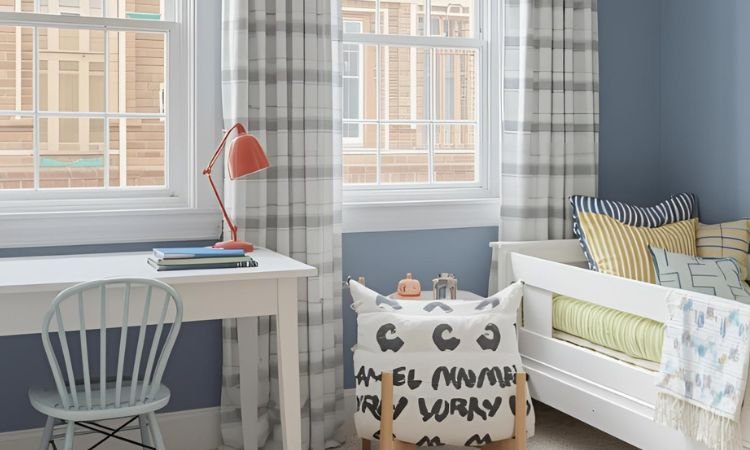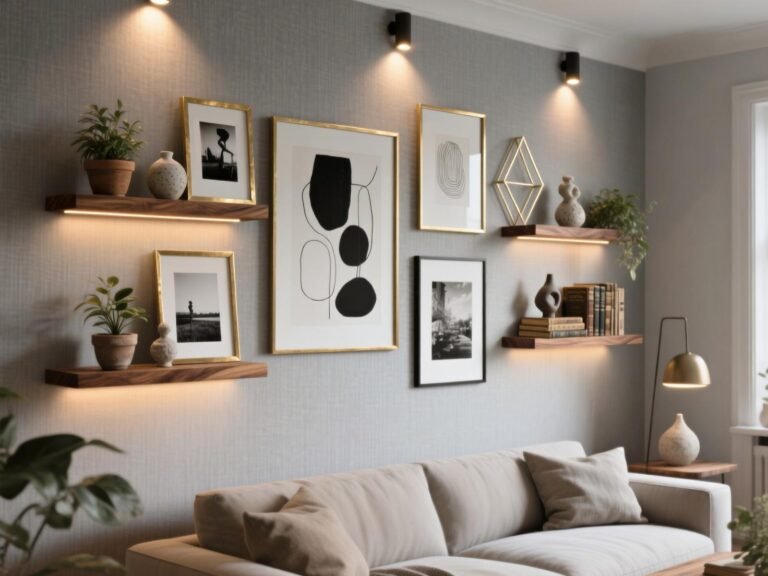Some Awsome Creative Bookshelves Ideas to Inspire Young Readers

Clutter and unread books can quickly overwhelm a child’s room, turning story time into a frustrating search rather than a joyful escape. A well-designed bookshelf isn’t just about storage; it’s about making books accessible, appealing, and integrated into a space that sparks imagination. The right setup can transform a jumble of stories into an inviting display, encouraging a love for reading from an early age.
This article addresses the common challenge of organizing children’s books in a way that is both practical and inspiring. We’ll explore 15 smart solutions that fit various room sizes and styles, ensuring every book has a place and every child feels drawn to explore new adventures. Get ready to discover creative ways to bring order and enchantment to your child’s literary collection.
These selections emphasize accessibility, safety, and aesthetic appeal, proving that functional storage can also be a delightful part of room decor.
Principles for Perfect Kids’ Book Storage
- Accessibility Matters Most: Books should be easy for children to reach and return independently. It’s like a self-service library where independence is encouraged. High shelves defeat the purpose of fostering early reading habits.
- Safety is Always First: Bookcases must be stable, anchored to walls, and free from sharp edges or pinch points. It’s like childproofing where protection is paramount. Secure installations prevent accidents in a playful environment.
- Durability Withstands Play: Kids’ furniture needs to endure active use, from frequent book handling to accidental bumps. It’s like heavy-duty equipment built to last. Robust materials ensure longevity through years of stories.
- Visual Appeal Invites Interest: A cheerful or themed bookshelf makes books more attractive than a plain box. It’s like an inviting display where presentation sparks curiosity. Engaging designs draw children into the world of reading.
15 Kids Room Bookshelf Ideas
Create organized and inspiring spaces for young readers with these imaginative bookshelf ideas.
1. Front-Facing Picture Ledges
Install shallow ledges or spice racks that display books with their covers facing out, making them easy for young children to identify and select. This encourages independent choice by showcasing vibrant artwork. It’s like a gallery wall for books, where visual appeal is maximized.
These ledges are particularly useful for toddlers and preschoolers, allowing them to see what’s available without having to pull every book out. Position them at a low height within easy reach for little hands.
2. Built-In Window Seat Storage
Design a cozy reading nook around a window with integrated shelving beneath the seat or alongside the frame. This maximizes unused space while creating an inviting spot to curl up with a book. It’s like a private library where comfort and convenience meet.
The combination of natural light and dedicated seating makes this a beloved spot. Ensure the shelving is open or has easily accessible bins for quick tidy-ups.
3. Tree-Shaped Bookcase
Opt for a whimsical bookcase designed to look like a tree with branches serving as shelves. This adds a playful, natural element to the room decor. It’s like bringing a storybook setting to life, where imagination takes root.
The unique shape acts as a focal point and can inspire nature-themed reading. Ensure the unit is securely anchored to the wall for safety.
4. Floating Wall Shelves
Install sturdy floating shelves at varying heights on an empty wall to create a customized display without taking up floor space. This offers flexibility in arrangement and can adapt as your child grows. It’s like modular art where functionality meets modern design.
Use a mix of lengths and depths to accommodate different book sizes and small decorative items. Always ensure these shelves are securely mounted into wall studs.
5. Sling Fabric Book Display
Utilize fabric slings stretched between two side supports, creating soft, shallow pockets where books can be stored cover-out. This is ideal for smaller children, as books are easy to grab and put back. It’s like a soft hammock for books, where accessibility is paramount.
The fabric design is gentle on books and fingers, and the cover-forward display promotes reading choices. These are often compact and safe for toddlers.
6. Repurposed Crate or Box Shelves
Stack or mount wooden crates or sturdy decorative boxes on the wall to create rustic, customizable shelving units. This is an economical and charming DIY option that adds character. It’s like upcycled treasure where old items find new purpose.
Ensure crates are clean, sanded smooth, and securely fastened together or to the wall to prevent tipping. Paint them vibrant colors to match the room’s theme.
7. Dollhouse Bookcase
Choose a bookcase shaped like a dollhouse, with different “rooms” serving as individual shelves. This playful design encourages imaginative play alongside reading. It’s like a dual-purpose toy where storage is part of the fun.
Children can organize their books by size or character in different sections of the dollhouse. This adds a unique, decorative element to the room.
8. Ladder Shelf Display
Incorporate a leaning ladder shelf unit for a stylish and accessible book display, particularly suitable for older children. The tiered design offers various shelf sizes and an open, airy feel. It’s like a contemporary sculpture where books are the main feature.
Ensure the ladder shelf is anchored to the wall and that heavier items are placed on lower shelves for stability. This style works well in slightly larger rooms.
9. Rolling Cart Book Storage
Use a multi-tiered rolling utility cart as a portable bookshelf, allowing books to be moved easily to different reading spots within the room or even to other areas of the house. This offers flexible and mobile storage. It’s like a mobile library where stories can travel.
Look for carts with sturdy wheels and brakes for safety. This is an excellent solution for keeping favorite books close to a bed or play area.
10. Wall-Mounted Book Bin
Install a deep, front-facing bin directly onto the wall for quick and easy storage of a rotating selection of books. This is perfect for keeping current favorites organized and visible. It’s like a quick-grab dispenser where books are always on display.
These bins are often shallower than traditional shelves, making it easy for kids to flip through books and select their next read. They work well in smaller spaces.
11. Personalized Letter Shelves
Create shelves shaped like your child’s initial or favorite letters. This adds a personalized touch to the room while providing functional storage for smaller books or treasured objects. It’s like an alphabet art installation where names become shelves.
These custom shelves can be made from wood or sturdy composite materials and painted to match the room’s color scheme. They serve as both decor and storage.
12. Closet Bookshelf Conversion
Transform an unused or lightly used closet into a dedicated reading nook with built-in or freestanding bookshelves. This maximizes hidden space and creates a private, quiet area. It’s like a secret hideaway where books await discovery.
Add a comfortable cushion, a small light, and perhaps some decorative wallpaper to make the space extra inviting. This works especially well in larger closets.
13. Corner Shelf Units
Utilize corner shelf units to make the most of often-overlooked vertical space in a room. These units fit snugly into corners, providing ample storage without impeding traffic flow. It’s like spatial optimization where every angle is used.
Corner shelves can be freestanding or wall-mounted, offering a range of styles from simple utilitarian to decorative. Ensure they are stable and secure.
14. Under-Bed Storage Drawers
Incorporate pull-out drawers or bins designed to fit under the bed, specifically for storing books. This keeps the room tidy and utilizes space that often goes unused. It’s like hidden treasure where stories are neatly tucked away.
Look for drawers with wheels for easy access and covers to protect books from dust. This is an excellent solution for maximizing storage in smaller rooms.
15. Themed Display Shelves
Choose bookshelves that align with your child’s favorite themes, like a castle, rocket ship, or animal shapes. This transforms storage into an interactive part of the room’s overall design. It’s like immersive storytelling where furniture joins the adventure.
These themed units can encourage imaginative play and make organizing books feel less like a chore and more like part of an ongoing adventure. Always prioritize stability and safety with unique designs.
Setting Up Your Child’s Reading Corner
- Curate the Collection: Rotate books regularly to keep the selection fresh and engaging, putting some away and bringing out others. It’s like a rotating exhibition where new stories always appear. This prevents overwhelm and maintains interest.
- Comfort is Key: Pair bookshelves with a soft rug, cozy beanbag, or comfortable chair to create an inviting reading haven. It’s like building a nest where relaxation encourages engagement. A comfortable spot makes reading more appealing.
- Involve Your Child: Let children help choose their books and arrange their shelves. This fosters a sense of ownership and responsibility. It’s like a collaborative project where their input matters. Involvement boosts their enthusiasm for reading.
Frequently Asked Questions About Kids’ Bookshelves
What height should bookshelves be for a toddler?
For toddlers, bookshelves should be low to the ground, with the highest shelf no more than 2-3 feet (60-90 cm) from the floor. This allows them to easily reach and return books independently, fostering early literacy skills.
Front-facing book ledges or sling-style bookshelves are particularly good for this age group, as they present book covers clearly at a child’s eye level.
How do I anchor a bookshelf to the wall safely?
To safely anchor a bookshelf, use anti-tip furniture straps or brackets that screw directly into a wall stud. If studs aren’t available, use heavy-duty wall anchors appropriate for your wall type (e.g., toggle bolts for drywall).
Always follow the manufacturer’s instructions for the anchoring kit. This simple step is critical for preventing tip-over accidents, especially in children’s rooms where climbing can occur.
What kind of bookshelf is best for a small room?
For a small room, opt for vertical storage solutions like tall, narrow bookcases, floating wall shelves, or corner units to maximize space without taking up floor area. Wall-mounted book bins or sling displays are also excellent for compact spaces.
Consider multifunctional furniture, such as a bed with integrated shelving or drawers underneath, to combine storage and sleeping areas efficiently.
How can I make books more appealing to my child?
Make books appealing by displaying them cover-out, creating a cozy reading nook, and rotating the selection regularly. Involve your child in choosing books from the library or bookstore.
Read aloud often, make reading a fun family activity, and show enthusiasm for stories. The physical environment of the bookshelf plays a significant role in inviting children to explore.
Is it better to have open or closed bookshelves in a kids’ room?
Both open and closed bookshelves have their advantages. Open shelves (like front-facing ledges) are great for making books visible and accessible, encouraging independent selection.
Closed storage, such as drawers or cabinets, helps hide clutter and can protect special books. A mix of both, with open shelves for daily reads and closed storage for less-frequently accessed items, often works best for balance.
Inspiring a Lifelong Love of Reading
Choosing the right bookshelves for a child’s room is about more than just organizing books; it’s about creating an environment where reading is celebrated and easily accessible.
By focusing on safety, accessibility, and engaging design, you can transform a simple storage solution into a powerful tool for fostering a lifelong love of literature. Thoughtful placement and creative choices ensure that books become treasured parts of their world, always within reach for the next great adventure.
Start by assessing your child’s age and room size, then select ideas that best fit their needs and your home’s style. Remember, an inviting book display can be the first step to countless imaginative journeys.
What bookshelf idea will you try first to spark your child’s reading joy? Share your favorites below!






